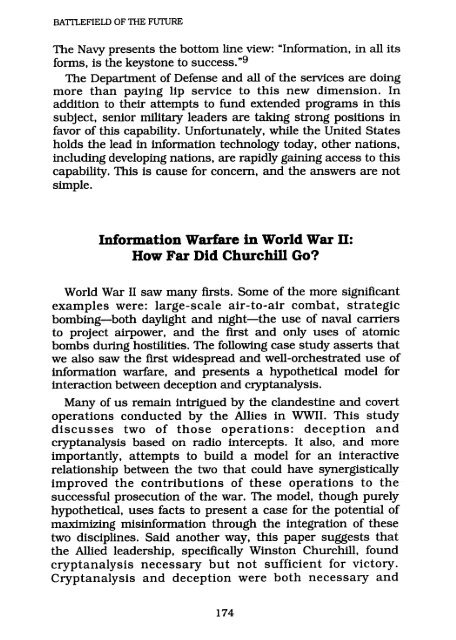BATTLEFIELD OF THE FUTURE
Battlefield of the Future - Air University Press
Battlefield of the Future - Air University Press
Create successful ePaper yourself
Turn your PDF publications into a flip-book with our unique Google optimized e-Paper software.
<strong>BATTLEFIELD</strong> <strong>OF</strong> <strong>THE</strong> <strong>FUTURE</strong><br />
The Navy presents the bottom line view : "Information, in all its<br />
forms, is the keystone to success . "9<br />
The Department of Defense and all of the services are doing<br />
more than paying lip service to this new dimension . In<br />
addition to their attempts to fund extended programs in this<br />
subject, senior military leaders are taking strong positions in<br />
favor of this capability . Unfortunately, while the United States<br />
holds the lead in information technology today, other nations,<br />
including developing nations, are rapidly gaining access to this<br />
capability . This is cause for concern, and the answers are not<br />
simple .<br />
Information Warfare in World War H :<br />
How Far Did Churchill Go?<br />
World War II saw many firsts . Some of the more significant<br />
examples were : large-scale air-to-air combat, strategic<br />
bombing-both daylight and nightthe use of naval carriers<br />
to project airpower, and the first and only uses of atomic<br />
bombs during hostilities . The following case study asserts that<br />
we also saw the first widespread and well-orchestrated use of<br />
information warfare, and presents a hypothetical model for<br />
interaction between deception and cryptanalysis .<br />
Many of us remain intrigued by the clandestine and covert<br />
operations conducted by the Allies in WWII . This study<br />
discusses two of those operations : deception and<br />
cryptanalysis based on radio intercepts . It also, and more<br />
importantly, attempts to build a model for an interactive<br />
relationship between the two that could have synergistically<br />
improved the contributions of these operations to the<br />
successful prosecution of the war . The model, though purely<br />
hypothetical, uses facts to present a case for the potential of<br />
maximizing misinformation through the integration of these<br />
two disciplines . Said another way, this paper suggests that<br />
the Allied leadership, specifically Winston Churchill, found<br />
cryptanalysis necessary but not sufficient for victory .<br />
Cryptanalysis and deception were both necessary and<br />
174

















